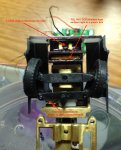Dear all,
Below is my line follower code. It is kind of working, but I believe it is too slow for actual operation even at the slowest speed of the car. Maybe I'm wrong. Or I hope I'm wrong . The symptom is I can read the line with with the model car in my hand and I do get correct steering wheel movement. However, when I run the car at the slowest possible speed, it is able to perform one correction in the right direction to miss the line completely after that, because it does not seem to manage to do the counter correction after overshooting the line.
. The symptom is I can read the line with with the model car in my hand and I do get correct steering wheel movement. However, when I run the car at the slowest possible speed, it is able to perform one correction in the right direction to miss the line completely after that, because it does not seem to manage to do the counter correction after overshooting the line.
Now, I know it is a lot to ask for anybody to look at a complete piece of code that does not even fit into the limit of the post here, but if you have any ideas on how I could improve the calculation parts to make response to steering error quicker, I would be very thankful.
It is not impossible, that there is an electromechanical problem - the steering wheels are just not turning fast enough physically. I have not figured how to calculate or assess that at this point.
View attachment LineFollowerCarTest20161212.bas
Just to give everyone a better idea of the physical setup, here is a picture of the underside of the front of the vehicle.

Thank you for your input,
Edmunds
Below is my line follower code. It is kind of working, but I believe it is too slow for actual operation even at the slowest speed of the car. Maybe I'm wrong. Or I hope I'm wrong
Now, I know it is a lot to ask for anybody to look at a complete piece of code that does not even fit into the limit of the post here, but if you have any ideas on how I could improve the calculation parts to make response to steering error quicker, I would be very thankful.
It is not impossible, that there is an electromechanical problem - the steering wheels are just not turning fast enough physically. I have not figured how to calculate or assess that at this point.
View attachment LineFollowerCarTest20161212.bas
Just to give everyone a better idea of the physical setup, here is a picture of the underside of the front of the vehicle.

Thank you for your input,
Edmunds
Last edited:
